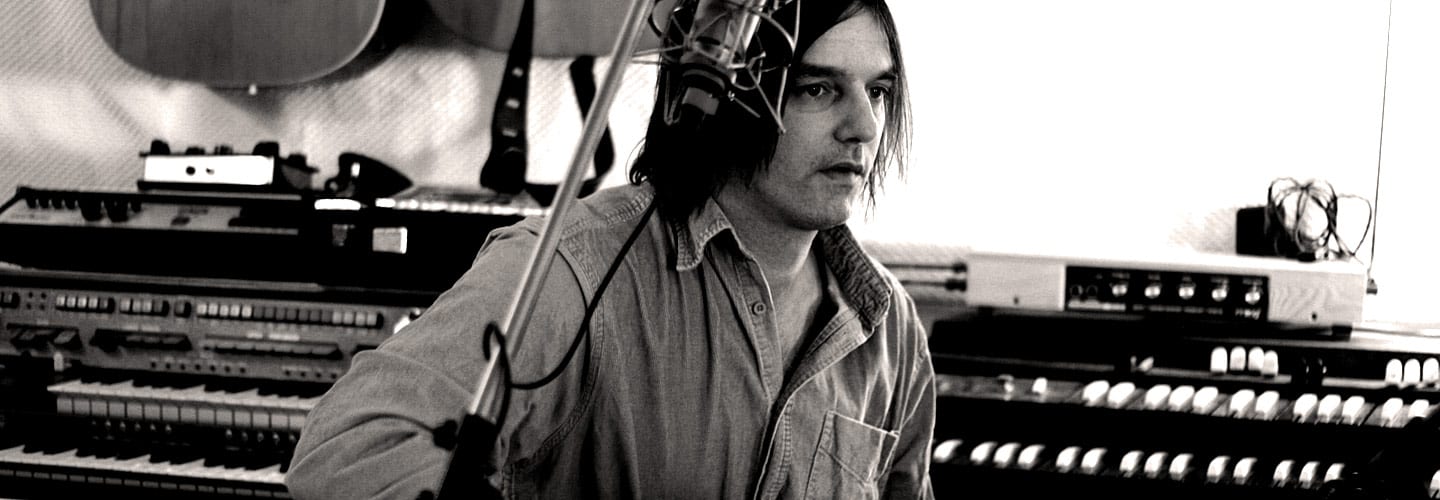Anton Newcombe is a Californian singer, songwriter, producer and multi-instrumentalist, most known for his psychedelic rock band ‘The Brian Jonestown Massacre’ (from now on referred to as ‘BJM’).
In an interview with Tenement TV (2016) [3:05-4:58], Newcombe mentions that he has been inspired by a variety of Scottish musical personnel. He states that he is really loves the approach Jesus & Mary Chain took towards the creation and production process in what he calls ‘do-it-yourself culture’ – this being the idea of creating your own songs, having a vision of what you want them to sound like an executing this, regardless of finances/resources/equipment. The whole organic nature of creating music according to how you feel, using it as an expressive medium more-so than one with alternative motives seems to be integral to how Newcombe has worked over the years, for better or worse.
When asked a question about sustaining his level of creativity over the duration of his career, Newcome introduces the concept of creating your own culture (Tenement TV, 2016) [6:03-6:54] by connecting with people, developing an “ecosystem” – a “little community” of people creating something that brings people together – forming a “folk” culture. A lot of this stems from him just “bumping into people” [9:09] and figuring out who exactly the person is behind the music and using his music as a platform for that person to find themselves. This approach to collaborating with individuals in an industry is one of the distinctive aspects of not only who he is as a creative mind but also of the music itself, as you can very much hear this collaboration across BJM’s music. Using their fourth album ‘Their Satanic Majesties’ Second Request’ album as an example, their liner notes are the following:
“acoustic guitar, sitar, clavs, mellotron, tambora, echoplex-feedback-generator, electric guitar, dumbek, tablas, flute, farfisa, recorder, tape loops, drums, acoustic bass, shinni, chanter, didgeridoo, vox jaguar, French horn, viola, tuba, SMS serge, 12-string electric guitar, harmonium, tambourines, cabasa, conga, jimbe, accordion, celeste, glockenspiel, bells, fish, piano, hammond, cello, wolf horn, maracas, weird-fucking-Chinese-shit, tyco drum, vibes, woodwinds and other top secret crap.”
This level of collaboration is what exactly provided Newcombe with the sound he was looking for. This album was recorded at Bloody Angle Studios in San Francisco, produced by Dave Deresinski and Naut Humon (Discogs, 2017).
During an interview Newcombe participated in for Louder Than War, he mentions that he often wants to create an “album experience” when creating his albums, as opposed the disjointed, singles-driven market we live in today (Stanley, 2014). This explains why many of his tracks feel like they belong together – it’s because he didn’t create them in isolation, they were always meant to be listened to collectively.
How does his production approach inform my own?
The idea of ‘do-it-yourself’ culture has a big appeal to me with this project – I feel like there is the chance to overproduce the tracks to the extent that its devoid of the emotion I’ve put into making the songs, and more so just turning into a ‘commercial mix’. Though I believe the mix will be commercially viable, I don’t want it to share some of the qualities of modern mixes, including every sound sounding ‘full’, rhythms being clinically constructed and being rigid in nature. I want my mixes to have a real sense of rhythm, not DAW ‘grid-induced rhythm’ and this can be achieved by having the drums recorded as well as they can be in one take and in time. Obviously, there will be edits between takes and to correct early/late rhythmic elements, but it’s more of a correction tool as opposed to an overhaul tool. In terms of not every musical instance sounding ‘full’ I’ll be using the full extent of the audible frequency spectrum, having low-end thumps from boxes and perhaps Cajon to carry the sense of rhythm, to guitars played through converted radio amplifiers to give a crunchy lo-fi distortion to thin weedy guitar hooks. This way the mixes will be audibly pleasing due to the full utilization of the audible frequency spectrum (we don’t live in a world where the ‘overall mix’ of sounds is mixed with a HPF at 50 kHz and a LPF at 8 kHz), which we as humans sound satisfying. Compression won’t be overall ‘heavy’ throughout – for some instances of electric guitar I may decide to compress them heavily to get a particular sound, but it will be more so for the effect I want as opposed to just ‘what you do’.
I also will be adopting the approach of using a wide array of physical instruments, from the voice, guitars, and drums, to less western instruments including djembe, didgeridoo and cabasa. This for me would be a great approach to emphasise the emotional content I am trying to push behind each song and create a multi-cultural sound, similar to the likes of BJM.
His take on collaboration is very inspiring for me – something I very much want to ingrain within my music. It’s great for me to create my music, but if I’m creating music with others it’s very much theirs as much as mine, so I want to use my music as a vehicle to connect with passionate people and use it as a means of shining a light on interesting people with interesting views and ideas.
Bibliography
Carl Stanley (2014) Louder Than War Interview: Anton Newcombe of the Brian Jonestown Massacre. [online] Louder Than War. Available from: http://louderthanwar.com/ltw-interview-anton-newcombe/ [Accessed 20 February 2017].
Discogs (2017) The Brian Jonestown Massacre – Their Satanic Majesties’ Second Request. [online]. Discogs. Available from: https://www.discogs.com/The-Brian-Jonestown-Massacre-Their-Satanic-Majesties-Second-Request/release/3643344 [Accessed 20 February 2017].
Tenement TV (2016) TTV TALKS: Anton Newcombe The Brian Jonestown Massacre Barrowlands 2016. YouTube. [online] Available from: https://www.youtube.com/watch?v=u1eEuE1-JA0 [Accessed 20 February 2017].
